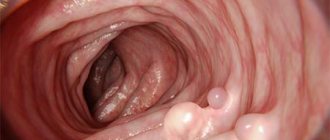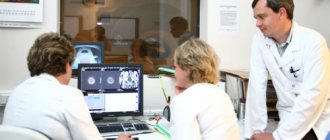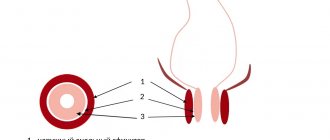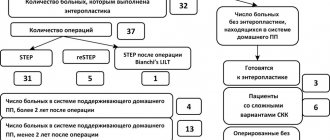Pneumatosis intestinalis is a rare pathology, but those who experience it should be aware of the possible complications and consequences. It is important to find out the reasons for its development. With early diagnosis and elimination of another disease, which most often leads to pneumatosis, we can talk about a favorable prognosis.
Pneumatosis intestinalis is characterized by the formation of air cysts in the thickness of the intestinal wall. The pathological process leads to a feeling of fullness, pain, belching, upset stool, nausea and vomiting.
general information
Intestinal pneumatosis is a condition of the gastrointestinal tract in which intestinal gases penetrate the thickness of the organ wall and form air cavities in it.
The pathology can be observed in patients of any age, but is more common in infants and the elderly, due to low physical activity and frequent disturbances in the gastrointestinal tract.
More often, the pathological process is localized in the submucosal or subserous layer of the colon or jejunum. In this case, the intestines may resemble bunches of grapes or soap scum in appearance; in rare cases, single air cysts form.
Their sizes can range from 0.5 to 5 cm in diameter.
Pneumatosis can develop in the large and small intestines
Pneumatosis intestinalis on ultrasound
Pneumatosis intestinalis is a pathological condition characterized by the appearance of cysts. New growths contain air or gases. If left untreated, the disease begins to spread. It often affects children and is discovered completely by accident. Pathology is not an independent disease. Accompanies major abnormalities of the digestive organ and intestinal tract.
Most often present during peristalsis, when gases are not able to be eliminated naturally, but accumulate in various parts of the gastrointestinal tract. If left untreated, serious complications develop. Pathology provokes the appearance of a large number of pathological signs.
Cysts in the intestines are usually complications of other gastrointestinal diseases.
The most life-threatening complication of pneumatosis intestinalis is peritonitis, when, as a result of increased pressure, the inflamed intestine ruptures and accumulated gases penetrate into the abdominal cavity. To avoid this most complex clinical pathology, timely therapeutic intervention is necessary.
Causes
The main cause of this condition is the pathological accumulation of gases in different parts of the intestine. Under normal conditions, gases are partially absorbed into the blood, the rest are excreted through natural pathways. With pneumatosis, they form air cysts, which prevents their removal from the body.
The development of pneumatosis is influenced by the following factors:
- Childhood. Pathology in children most often develops as a consequence of severe food poisoning.
- Intestinal obstruction of any form is a mechanical obstacle to the natural release of gases.
- Poor peristalsis. Impaired intestinal motility does not allow gases to escape through natural pathways, so they accumulate in various parts of the gastrointestinal tract, most often in the large intestine.
- Severe infectious lesions of the small and/or large intestine, the consequence of which is increased gas formation as a result of the activity of pathogenic microorganisms. Gas accumulates in the damaged intestinal lining.
- An increase in pressure inside the peritoneum and intestinal spasms lead to the appearance of compressed areas through which gases formed in the intestines cannot escape and accumulate in different sections.
- Inability to pass gases through the anus. This condition can develop for several reasons: when polyps or tumors form in the rectum.
Intestinal pneumatosis can also form against the background of colitis, appendicitis, adhesive disease, intestinal and/or stomach ulcers, and oncological diseases of the gastrointestinal tract.
Gastrointestinal infections are one of the causes of intestinal pneumatosis
Reviews and results
This disease is quite rare and patient reviews are very rare. This diagnosis is most often made during an abdominal ultrasound in children under one year of age, which makes parents worry. In fact, they have ordinary flatulence (increased accumulation of gas in the intestinal lumen), which should be designated by the term hyperpneumatization of intestinal loops or echo signs of intestinal flatulence.
- “... Against the background of nonspecific ulcerative colitis (he has been around for 13 years), pneumatosis developed. I began to worry about a strong and almost constant seething, transfusion and rumbling in one place - in the left side of the abdomen under the left rib. There is a feeling of balloons that roll when you press on them. They took an X-ray of the intestine - the left dome of the diaphragm is raised due to intestinal pneumatosis in the area of the splenic flexure. I am undergoing treatment for my underlying disease and constantly stick to a diet. The doctor said that if it progresses and is very bothersome, then it will be necessary to undergo surgery”;
- “... They did an ultrasound on the child and found severe pneumatosis intestinalis! I read that it was scary, I was seriously scared, and I didn’t sleep that night. We went to the pediatrician the next day and she said it was just bloating. I need to stick to a diet, give the child a tummy massage, apply heat and give dill water, espumisan, etc. As it turned out later, many of my friends with infants also went through this “diagnosis” and were not themselves. Well, how can you scare people like that?”
Development mechanism
The mechanism of development of the pathology is not fully understood. There are three theories of the formation of intestinal pneumatosis: pulmonary, infectious and mechanical.
Bowel research methods
According to the pulmonary theory, pneumatosis of the colon and small intestine occurs as a result of chronic lung diseases (bronchial asthma, COPD). From constant coughing, microscopic tears of the alveoli occur, pneumomediastinum occurs, which leads to the spread of air into the retroperitoneal space. From there, the free gas diffuses into the intestinal wall and accumulates under the serosa. According to the infectious theory of the origin of the disease, the gases produced by the bacteria penetrate the inflamed intestinal wall and can merge to form large blisters.
In gastroenterology, the mechanical theory of pneumatosis has received the greatest recognition. According to it, intestinal air cysts arise from primary pathologies of the gastrointestinal tract, such as tumors, enterocolitis, stenosis, and congenital anomalies of the blood and lymphatic vessels of the intestine. Against the background of diseases of the gastrointestinal tract, traumatization and thinning of the inner lining of the intestine occurs. The gas, under the influence of intraintestinal pressure, passes through microdefects, enters the submucosal lymphatic vessels and spreads through peristalsis in the submucosal layer of the intestine. Cysts are lined with epithelium on the inside and can contain various gases: oxygen, nitrogen, hydrogen, argon, carbon dioxide and others.
Classification
Doctors distinguish two subtypes of the disease:
- widespread (extensive);
- limited (local).
More common is the limited type, in which the pathological process is localized in the wall of the small intestine. But in the second form, the disease covers the entire intestine.
The areas most susceptible to the disease are:
- ileum;
- ileocecal zone.
In both types of diseases, changes occur in the intestinal mucosa, causing the appearance of cysts. Such neoplasms can accumulate in one area or be evenly distributed throughout the entire intestinal wall.
Symptoms
There are no complaints typical for pneumatosis; they are all associated with the processes that occur in the abdominal cavity.
Cystic pneumatosis, or pneumatosis intestinalis, is a rare pathology, so few observations have been accumulated to accurately describe the clinical picture of the disease.
The severity and severity of intestinal and extraintestinal manifestations depend on the extent and progression of the process.
Bloating, discomfort, pain are the most common complaints of patients with pneumatosis intestinalis.
The main complaints with intestinal pneumatosis are manifestations of flatulence: an excess amount of gases is formed in the intestines, which greatly stretch the intestinal wall, causing severe discomfort in the abdomen, a feeling of fullness, pressure, and pain.
The passage of peristaltic waves of the intestine can be accompanied by cramping pain, problems with stool can often be noted, and this can include diarrhea or constipation, lasting up to several days.
Severe pneumatosis intestinalis can lead to intestinal obstruction due to the closure of the intestinal lumen by swollen air cysts. Often, the gas pressure inside the intestine increases too much, resulting in rupture of gas cysts, with the penetration of intestinal contents and gases into the abdominal cavity with symptoms of peritonitis.
Signs of pneumatosis can be heaviness in the abdomen, belching, a feeling of fullness of the intestine with air, the passage of gas, abdominal pain along the intestine, relief of pain after stool, nausea and even vomiting.
With the development of peritonitis, the condition is sharply disrupted, pallor, abdominal pain and a “dumb stomach” without signs of peristalsis, decreased pressure, and a state of shock occur.
How to suspect something is wrong?
In what cases should you visit a doctor and undergo a comprehensive examination? If a person notices increased flatulence, then this is a serious reason to think about whether everything is in order in the body. As a rule, this symptom appears suddenly and sharply.
Another obvious manifestation of pathology is constipation. How strongly it is expressed is determined by the degree of intestinal damage. Which part of the gastrointestinal tract is under attack also plays a role.
Since the disease is characterized by disorders such as bloating and gas formation, the intestinal walls stretch over time, which becomes the cause of a cramping pain syndrome that comes without warning, suddenly. The patient also regularly notes discomfort, unpleasant, even painful sensations in the intestinal area.
The list of symptoms includes diarrhea. Some patients complain of colic.
Diagnostics
Diagnosis of such a pathological condition most often occurs when diagnosing another disorder or disease of the gastrointestinal tract.
The doctor can determine the presence of bubbles by examining and palpating the patient’s abdomen. This is only possible if there are large areas of damage to the intestinal walls. During this procedure, the patient may feel small gas bubbles bursting inside their abdomen.
Diagnosis of pneumatosis includes hardware examination
Such an examination is not enough to establish an accurate diagnosis. To do this, at the first stage of examining the patient, radiography is performed. Such a diagnosis allows you to find exactly where in the intestine there is an accumulation of air bubbles and determine the approximate number of cysts.
Upon further examination, the patient is prescribed a colonoscopy procedure. Using a special device that is placed in the intestinal cavity, the doctor can visually examine and assess the condition of the cysts and the condition of other parts of the intestine.
A visual internal examination of the intestine allows a gastroenterologist to examine its walls in more detail, to rule out their perforation and some other diseases that have similar symptoms. For a more accurate laboratory examination, tissue from the damaged intestine is taken from the patient for a biopsy.
Pneumatization of the intestine can harm not only the gastrointestinal tract, but also the entire body as a whole, so it is recommended to additionally donate blood for analysis: biochemical and hemoglobin.
Differential diagnosis of pneumatosis is carried out with nonspecific colitis, pneumoperitoneum, diverticula and intestinal duplication. With complete obstruction, intestinal obstruction of another etiology is excluded.
The main diagnostic methods in the table:
| X-ray of the abdominal cavity | Makes it possible to identify bubbles of different sizes arranged in a chain. Pneumatosis is characterized by the presence of double ring-shaped shadows in swollen intestinal loops. |
| Colonoscopy | Allows you to visualize gas bubbles, assess the extent of the lesion and the condition of the gastrointestinal mucosa. If necessary, the endoscopist performs a biopsy of a section of the intestine for histological analysis. |
| Irrigoscopy | Allows you to determine the presence of excess gas in enlarged loops of the large intestine in the form of several closely spaced round shadows separated by a wall. During the study, areas of narrowing of the lumen, pathological neoplasms, and ulcerations of the intestinal tube can be detected. |
Note!
Why does increased intestinal pneumatization occur? Medicine knows many reasons, but the most common is stomach diseases. And sometimes it’s all about tissue infection.
The disease is often accompanied by spasms, and in some patients they are quite painful. Abnormal bowel movements are observed in an adult patient.
The disease often manifests itself in very young children. The risk group is children who have had intestinal infectious diseases.
Complications
Pneumatosis can be dangerous if complications develop that are caused by improper treatment or lack thereof. Complications include the following pathological conditions:
- Intestinal obstruction. Caused by blockage (obstruction) of the intestinal lumen, it can be partial or complete. Its causes are an increase in the number of air cysts and an increase in their size. With obstructive intestinal obstruction, intoxication of the body develops, which can lead to toxic shock and death.
- Active formation of intestinal adhesions due to the proliferation of cavities.
- Volvulus or intussusception (invasion of one part of the intestine into the lumen of another). This occurs due to a change in the shape of the intestinal loops due to an increase in intraintestinal pressure.
- Perforation of the intestinal mucosa. It occurs due to increased pressure inside the intestines due to untimely release of gases.
- Necrosis and impaired circulation in the intestinal wall as a result of disruption of its nutrition due to the pressure of gas cysts. Necrosis of areas and excessive pressure on the wall can lead to its rupture and the release of intestinal contents into the abdominal cavity. This is fraught with peritonitis and the development of sepsis (blood poisoning).
How dangerous is the disease?
The concept of pancreatic pneumatosis, what it is and what the reasons for its development are, still remain a mystery to medicine. Experts are only guessing what kind of illness it is. If the disease occurs as a result of infectious or parasitic pathogens, the inflammatory process can spread to the liver and kidneys. With the development of an advanced stage in the form of hyperpneumatosis, death may occur. Treating pneumatosis is not so difficult. The main thing is to consult a specialist in time and follow all the doctor’s recommendations. It is also worth undergoing preventive examinations periodically.
Treatment
Since intestinal pneumatosis most often occurs against the background of other gastrointestinal diseases, drug therapy includes treatment of the underlying disease. But if the manifestations of pneumatosis are pronounced or pose a real threat to the patient’s life, then symptomatic therapy is indicated. Thus, if signs of intestinal obstruction or peritonitis increase, urgent surgery and, if necessary, drainage of the abdominal cavity are indicated.
Symptomatic therapy
Treatment of pneumatosis intestinalis consists of the following measures:
- For persistent constipation, laxatives are recommended. These can be herbal infusions and decoctions (senna grass, buckthorn bark, joster fruits), as well as Lactulose syrup, Duphalac, Prelaxan.
- For diarrhea, antidiarrheal drugs (Loperamide, Imodium) are prescribed.
- In case of excessive gas formation, the use of Espumisan and Meteospasmil is recommended.
- For pain, taking antispasmodics (Baralgetas, No-Shpa, Drotaverine) is indicated.
- For nausea and vomiting, Metoclopramide and Cerucal are prescribed.
Traditional medicine recipes
As an additional measure to the main treatment prescribed by the attending physician, traditional methods can be used.
Experienced herbalists suggest drinking a decoction of chamomile. At 2 tbsp. l. herbs you need to take a glass of water. Boil over low heat for about five minutes. Then let it brew for several hours. After this, strain and take 20 ml before meals before each meal.
A decoction can be prepared from parsley seeds. Pour 2 tbsp into a small saucepan. spoons of seeds, pour 500 ml of boiling water, put in a water bath for 1 hour. You need to drink the decoction every 4 hours, 1 tbsp. spoon.
To treat pneumatosis intestinalis, an infusion of dandelion root is used. It needs to be dried, crushed and filled with boiled cold water (for 2 teaspoons of raw material - 1 glass of water). Leave for 8 hours, then strain and take ¼ cup before meals.
Dandelion root infusion is used to treat pneumatosis intestinalis.
Diet
Treatment of pneumatosis intestinalis involves mandatory adherence to a diet. Proper nutrition of patients helps alleviate the condition, normalize stool and gas, and also serves as a prevention of serious complications.
It provides:
- Avoid foods that increase fermentation and gas formation in the intestines. These products include: turnips, radishes, legumes, cabbage, bananas, sweet apples, grapes, raisins, mushrooms, baked goods, brown bread, any fresh bread, milk, cucumbers, garlic, onions, oats, kvass, carbonated drinks, beer .
- Include foods that do not cause gas in your diet. This is dried wheat bread, boiled lean meat, greens, zucchini, pumpkin, carrots, beets, fermented milk products, cereals (except millet and pearl barley), green tea, freshly squeezed juices (lemon, apple, orange), grants, apricots, prunes.
- Eat 6 times a day. During an exacerbation, switch to pureed, mushy foods that do not irritate the gastrointestinal tract; during remission, you can eat unprocessed foods.
- Steam or boil dishes. Vegetables are consumed mainly in boiled form.
- If you are prone to diarrhea, eat foods that reduce motility and are rich in tannin (tea, infusions and compotes of blueberries, quince, bird cherry, pomegranate), as well as viscous dishes (puree soups, jelly, pureed porridges).
- If you are prone to constipation, it is recommended to use beet infusions, boiled beets, any boiled vegetables, baked fruits, prunes, whole grain cereals, and add vegetable oils to dishes. You need to increase the amount of vegetables gradually, since a large amount of fiber can increase flatulence.
- Dishes from boiled lean meat, fish and poultry, freshly prepared cottage cheese and fermented milk products.
- Constant use of decoctions of fennel seeds, anise, dill, and cumin before meals.
Fully or partially limited products
- Products that cause flatulence are completely excluded. It can occur when consuming highly starchy foods (potatoes, legumes), foods with a lot of coarse fiber (grapes, raisins, cabbage, onions, radishes, turnips, peppers, radishes, bananas, mushrooms), carbonated drinks, black bread, bran bread , whole grain bread, bread with seeds and cereals, yeast baked goods and sweets. For the same reasons, raw vegetables are excluded or limited.
- Jam, dried fruits, honey are limited. Sugar up to 50 g (in all dishes). A large amount of animal protein consumed at night can also cause flatulence. This is due to the fact that incompletely digested proteins in the intestines cause rotting and gas formation.
- Porridges made from millet, barley, and pearl barley are considered coarse and poorly digestible food, so they are excluded from the diet.
- Fatty broths, fatty meats, fish, and canned food are prohibited. You cannot eat sauces, marinades, or smoked foods.
- Whole milk and cream can cause diarrhea in patients and also cause bloating.
- Drinks with gas, kvass, and grape juice increase peristalsis and bloating, and therefore are not allowed in the diet of patients.
Table of prohibited products
| Proteins, g | Fats, g | Carbohydrates, g | Calories, kcal | |
Vegetables and greens | ||||
| vegetables legumes | 9,1 | 1,6 | 27,0 | 168 |
| horseradish | 3,2 | 0,4 | 10,5 | 56 |
Fruits | ||||
| bananas | 1,5 | 0,2 | 21,8 | 95 |
| melon | 0,6 | 0,3 | 7,4 | 33 |
Berries | ||||
| grape | 0,6 | 0,2 | 16,8 | 65 |
Mushrooms | ||||
| mushrooms | 3,5 | 2,0 | 2,5 | 30 |
Nuts and dried fruits | ||||
| raisin | 2,9 | 0,6 | 66,0 | 264 |
Cereals and porridges | ||||
| pearl barley | 9,3 | 1,1 | 73,7 | 320 |
| millet cereal | 11,5 | 3,3 | 69,3 | 348 |
| barley grits | 10,4 | 1,3 | 66,3 | 324 |
Bakery products | ||||
| vysivkovy bread | 9,0 | 2,2 | 36,0 | 217 |
| Old Russian grain bread | 9,6 | 2,7 | 47,1 | 252 |
| Rye bread | 6,6 | 1,2 | 34,2 | 165 |
Confectionery | ||||
| jam | 0,3 | 0,2 | 63,0 | 263 |
| jam | 0,3 | 0,1 | 56,0 | 238 |
| candies | 4,3 | 19,8 | 67,5 | 453 |
| pastry cream | 0,2 | 26,0 | 16,5 | 300 |
| cookie | 7,5 | 11,8 | 74,9 | 417 |
| cake | 3,8 | 22,6 | 47,0 | 397 |
Ice cream | ||||
| ice cream | 3,7 | 6,9 | 22,1 | 189 |
Cakes | ||||
| cake | 4,4 | 23,4 | 45,2 | 407 |
Raw materials and seasonings | ||||
| seasonings | 7,0 | 1,9 | 26,0 | 149 |
| mustard | 5,7 | 6,4 | 22,0 | 162 |
| ketchup | 1,8 | 1,0 | 22,2 | 93 |
| mayonnaise | 2,4 | 67,0 | 3,9 | 627 |
| tomato sauce | 1,7 | 7,8 | 4,5 | 80 |
| spicy tomato sauce | 2,5 | 0,0 | 21,8 | 98 |
Dairy | ||||
| milk | 3,2 | 3,6 | 4,8 | 64 |
| sour cream | 2,8 | 20,0 | 3,2 | 206 |
Meat products | ||||
| pork | 16,0 | 21,6 | 0,0 | 259 |
| ham | 22,6 | 20,9 | 0,0 | 279 |
Sausages | ||||
| dry-cured sausage | 24,1 | 38,3 | 1,0 | 455 |
| sausages | 10,1 | 31,6 | 1,9 | 332 |
| sausages | 12,3 | 25,3 | 0,0 | 277 |
Bird | ||||
| duck | 16,5 | 61,2 | 0,0 | 346 |
| goose | 16,1 | 33,3 | 0,0 | 364 |
Fish and seafood | ||||
| dried fish | 17,5 | 4,6 | 0,0 | 139 |
| smoked fish | 26,8 | 9,9 | 0,0 | 196 |
| canned fish | 17,5 | 2,0 | 0,0 | 88 |
Oils and fats | ||||
| creamy margarine | 0,5 | 82,0 | 0,0 | 745 |
| animal fat | 0,0 | 99,7 | 0,0 | 897 |
| cooking fat | 0,0 | 99,7 | 0,0 | 897 |
Alcoholic drinks | ||||
| whiskey | 0,0 | 0,0 | 0,4 | 235 |
| vodka | 0,0 | 0,0 | 0,1 | 235 |
| cognac | 0,0 | 0,0 | 0,1 | 239 |
| liquor | 0,3 | 1,1 | 17,2 | 242 |
| beer | 0,3 | 0,0 | 4,6 | 42 |
Non-alcoholic drinks | ||||
| bread kvass | 0,2 | 0,0 | 5,2 | 27 |
| Pepsi | 0,0 | 0,0 | 8,7 | 38 |
| sprite | 0,1 | 0,0 | 7,0 | 29 |
Juices and compotes | ||||
| grape juice | 0,3 | 0,0 | 14,0 | 54 |
| * data is per 100 g of product | ||||
Forecast
Depends on the underlying disease that caused pneumatosis. In children of the first year of life, the prognosis is always favorable, since the digestive system becomes more perfect every day. After reaching 6 months of age, intestinal colic caused by pneumatosis begins to decline.
In old age, it is enough to streamline your diet and slightly increase physical activity for your condition to noticeably improve.
Pneumatosis caused by tumors and infectious diseases is especially dangerous. Cases of obstruction and peritonitis with isolated pneumatosis are extremely rare. Treatment of relevant diseases is carried out before complications occur.
Prevention of pneumatosis intestinalis
Prevention includes timely implementation of therapeutic measures to eliminate ailments of the digestive system. A person should undergo medical examinations every year to detect the onset of the disease in time. If the patient is worried about any signs, he should immediately seek medical help.
Only a doctor can explain how to treat the disease. He will prescribe a complex that includes drug therapy, folk remedies and diet. Prevention includes timely implementation of therapeutic measures to eliminate ailments of the digestive system. A person should undergo medical examinations every year to detect the onset of the disease in time.
What drugs help?
With intestinal pneumatization, antibiotics and some other drugs taken under the supervision of a doctor are beneficial. It is important that the doctor monitors the patient’s condition at all times to avoid additional complications.
The practice of treatment with prebiotics is widespread. This is the common name for drugs that stimulate the growth of colonies of beneficial bacteria in the intestines. Problems with peristalsis are often caused by microflora disturbances, and such medications give good results. Otherwise, all those particles that are not broken down by gastric juice decompose in the intestines with the formation of gases.
Enzyme preparations are another group of medications that are in demand for problems with peristalsis. They improve digestion and normalize the process of digesting foods.
Therapy with choleretic drugs shows remarkable results. If the disease is associated with spasms, drugs based on drotaverine will come to the rescue. But if the appearance of gas is accompanied by the production of foaming mucus, medications that contain simethicone will help. The best results can be achieved by combining drug therapy, proper nutrition and control of work and rest patterns.
What is allowed?
Because of the list of restrictions listed above, you may get the impression that you can’t eat anything at all. In fact, this is not so - the variety of foods and dishes allowed and even recommended for intestinal motility disorders is great.
Cereal porridges boiled in water are extremely useful:
- buckwheat;
- millet
It is recommended to either steam or cook any food before eating. You can simmer. But you shouldn't eat fried food. Only those flour products that were made from coarsely ground raw materials can be eaten.
To achieve the maximum positive effect from the diet, you need to eat strictly according to the schedule. This regimen will help normalize the production of gases in the intestines and improve the health of the body. You should eat small portions, but at least six times a day.
Eat slowly, chewing all food thoroughly. Remember that when talking while eating, a person involuntarily swallows air, which only aggravates the situation. It is recommended to eat at the same time every day.








